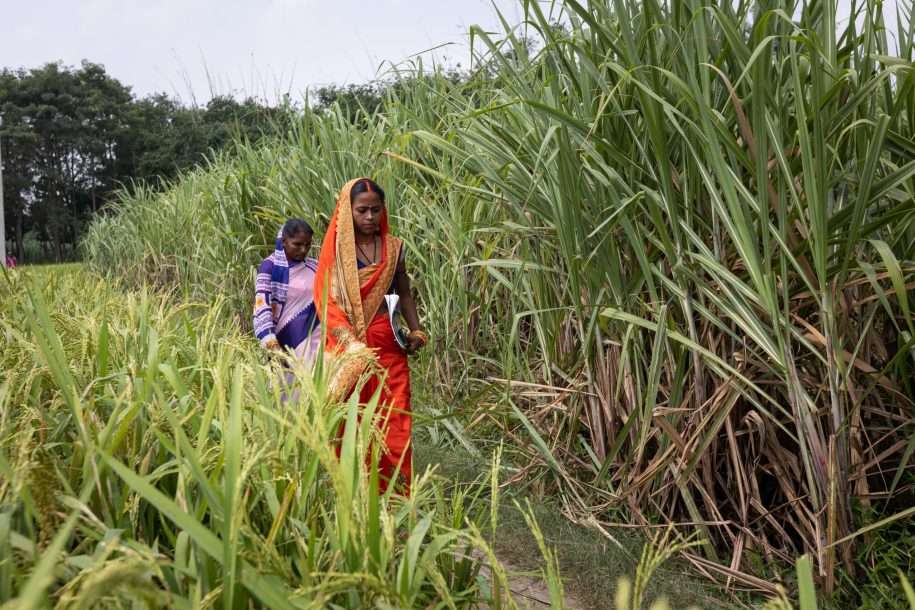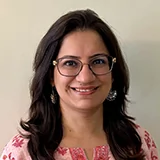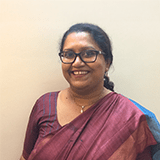How do women intermediaries build trust in rural India’s last-mile delivery? In part 3 of this series, Ava Haidar from Aapti Institute deconstructs the vital role of ASHAs, Anganwadi Workers, and Bank Correspondent Sakhis in bridging communities with digital services and fostering trust.
Introduction
Women’s engagement in the digital space has seen marked increases in India, in the past few years – we see a rise in internet usage from 31% in 2022 to 37% in 2023. Factors such as greater internet penetration and the digitising impact of COVID have played a role in leveling the digital access for all, especially women. Yet, India faces gender gaps in the ownership of devices and usage of digital mediums, at 12% and 30%, respectively.
Against this backdrop, we see the role of a strong supportive network led by women intermediaries, namely, ASHAs, AWWs and Bank correspondent Sakhis, in plugging these technological gaps for women in their communities. These women are deputed to ensure the multiple needs of their wards are tracked, fulfilled and delivered. On one hand, this reveals the state’s conception of welfare and digital access as not imagined at the individual level, but rather, at the level of ‘community.’ It also throws light on the high levels of trust between citizens and intermediaries that are required for the state’s delivery system to operate. This piece focuses on unbundling the links of digital trust that undergird community relationships with intermediaries, as well as how they specifically play the role of ‘trustees’ for other women.
How Does the Intermediary Build Trust with Her Community?
In patriarchal societies, women must work tirelessly to excel in leadership roles. They act against gendered containment into the roles of mothers, daughters and merely “women” of the household; often this requires them to juggle their duties of home and household with education, working doubly hard as compared to men to attain professional purpose.
As we see with Rama in Shravasti’s Mohinipur district, a Panchayat Sahayak aspiring next to become an ANM, the value of having purpose drives being “padhi-likhi” (educated) and capable of a ‘respectable’ lifestyle in extremely gendered social contexts.
These women are often the in-betweeners of citizens and their essential services, acting as mediators for healthcare (ASHAs), nutrition (AWWs) and financial transactions (BC Sakhis). The state entrusts them to enrol citizens as wards under these services and build community-level awareness, acceptance and availability of government schemes. Rooted in notebooks, forms and registers, the work of these intermediaries is today highly dependent on digital platforms and portals. They input data around their wards’ maternal health, nutrition delivery, registrations with essential service IDs (e.g. Health ID, Aadhaar), as well as lend digital capacity in financial services (acting as proxies to ATMs).
In this way, the state constructs the intermediary as the holder and facilitator of community interests, but also as the collector of massive amounts of data about efficiencies and gaps in delivering services to these regions. Given the wide ambit of this responsibility, how does ‘trust’ become important to these relationships?
The way that intermediaries are “embedded” in communities is a key instance of trust-building. For instance, the ASHA generally emerges from the community she is entrusted, or is its “bahu”, i.e., married into a family from it. This ensures that wards in tolas and panchayats can identify with an “insider” or “one of their own” in the issues of their health. She is also a recognisable human touchpoint between them and digital health services, creating a safe and familiar buffer between complex navigation of government systems and people’s ability to use digital platforms confidently.
The ASHA and other intermediaries are also seen as highly competent in terms of digital capacity – this reinforces the trust that people have in her ability to ‘authenticate’ them and their interests online. As earlier mentioned, intermediaries are often seen as “padhi-likhi” or well-educated, given that they must pass a series of evaluations to assume their responsibility, creating a tested reputation of reliability. There is a strong belief of their digital competence at the community level, and so wards also lean on intermediaries to help them with their own digital needs. For example, ASHAs are approached to help women send money through their own payment IDs to relatives living far away. They are also approached for more general knowledge around using phones, helping to troubleshoot in situations where people find themselves stuck. While this speaks to the faith they have in her ability, it also highlights the importance role she plays as that safe “buffer.” This understanding is formalised through the structure of the BC Sakhi, who is deputed to deliver financial services through her role as touchpoint between her wards and the bank or ATM.
The service nature of her role, as well as how she extends herself beyond it to serve personal digital needs, increases the feeling of safety that drives the community’s trust. This also connects to a third instance of trust-building, which is a treatment of the intermediary as an extension of the government’s benevolence; the Anganwadi worker, in this case, is considered responsible for the material delivery of nutrition, and accountable to the ‘numbers’ she must input to track the overall growth of the more vulnerable members of the community, i.e., malnourished children, expectant mothers, and adolescent girls. However, she isn’t just performing a function for community wellbeing – she is also enveloped in the ‘system of care’ that allows people to see her service as empathetic and personally invested. In this context, trust is also almost a requirement of one’s relationship with her, as the delivery structure presupposes community dependence on her to ensure group health, financial confidence and overall wellbeing guarantees. She is also seen as the representative of the community towards the government, thus pushing the overall tone of this relationship to be based on accountability.
How Does the Intermediary Build Trust with Women?
There are also ways in which women specifically benefit from a trust relationship with intermediaries. The sensitive nature of their maternal and menstrual needs against the backdrop of superstitions, traditions and gendered norms in Indian societies means that women do not always receive the informational support required to make decisions about their health. There is greater reliance on familial opinion and practice, such as using old blankets to wrap newborns, which can impede their quality of health as well. The stigmas of impurity and shame around menstruation also continue to make it difficult for women to ask for information and help. To access quality and scientific healthcare, women require empathetic and relatable conduits to freely discuss their concerns and experiences. ASHAs, AWWs and Auxiliary Nurse Midwives (ANMs) then become more than just trackers of data and sources of information; their interactions are sacred spaces for the exchange of personal and digital apprehensions, requiring a great amount of trust maintenance.
Given the intermediary’s reputation of being educated and professional, women also build aspirations around her example. There are two values at play here: one of being literate, intelligent and capable of complex digital functions, and the second of being “useful” to the community, being in service to her family and social landscape through a high-stakes responsibility. Women then see the intermediary as trustworthy, both at the level of her digital reliability, and her personal investment towards them. Gaining her ‘title’ means an elevation of the self into a role of importance and leadership within her social environment; she becomes one of its custodians.
Finally, women seek non-service-based digital learning directly from the intermediary in many instances – she helps people learn how to problem-solve issues on their devices, teaches them how to use particularly-risky platforms (such as payment applications), and as earlier mentioned, allows them to use her own device to send money or contact their relatives. For women, this interaction provides a non-judgemental space to build digital ability and confidence. The intermediary can cast away fears and onboard other women from a position of empathetic understanding and connection, as well as possibly an acute sense of the specific reasons within their community that prevent women from being able to hone digital skills on their own.
The Present Challenges with Maintaining Digital Trust
In understanding the multivarious impact of the intermediary, we must also turn our attention to how she responds to the challenges that come with upholding a digital ecosystem. Over the past few years, there have been rising concerns around the wages of Anganwadi workers, who spend over 9 hours a day completing their work; while their designated hours are from 9AM to 2PM, they spend many hours “[filling] data on their smartphone and work till midnight.” This strain on their time, as well as a lack of recognition of a “government worker status”, is compounded by a lack of wages and “negligible” incentives that have come to characterise their increased responsibilities in light of more digital work.
On top of the expectations of data entry, there is the issue of unstable network, non-functional devices, limited funds for data-packs, glitches and digital language barriers in some states, which impedes the overall ability of AWWs to meet their tasks. While challenges around these issues have been met by responses of the state, the question on how “trustworthy” the infrastructure can be for AWW and intermediary performance still looms large. There must be efforts to reconfigure the burdens of digital platformisation of intermediary work – this means looking at ways to transform the digital interface considering low network connectivity and non-adaptive interfaces. Incentives (monetary and linked to data entry) must also be reimagined, as they currently encourage the idea of the intermediary’s profession as performance-based, which a) overlooks the other ways that incentives can be designed for more care-based relationships, and b) sets quantifiable and comparable expectations around doing work for the state’s purposes of digital growth and efficient data utilisation. And so, the concept of intermediary duty as ‘work’ and not ‘volunteership’ is also important to be grappled with to fulfil their expectations from their new role and accord fair remuneration.
Finally, it is necessary to heed the social perception of ASHAs, AWWs and other intermediaries as being “responsible” enough to do digital work as a key understanding of how rural women aspire to professional roles. Women’s digital confidence, self-esteem and capacity are intertwined with the reputation of work that comes with digital and data-led platformisation of community and welfare work. To be a trustworthy woman is perhaps at the core of the task of building independent and empowered digital participation of women in rural Indian societies.
Photo Credit: Mansi Midha/Getty Images
This article was first published on GxD (Gender x Digital) hub’s Blog. GxD hub is an initiative of LEAD at Krea University. Read the original piece here.
About the Author
Ava Haidar is a Political Science graduate, with research experience in literature and music. Her interests are in dilemmas of digital access, social transformations through technology and digital forms of social representation. Currently, her research focuses on understanding women’s digital trust in India, along with a deeper consolidation of global frameworks around digital trust and safety. Her past work includes crafting regulatory frameworks in projects with Omidyar Network India and Meta. Before joining Aapti, Ava worked as a Teaching Fellow at Ashoka University, where she taught students political theory, helped create online-friendly curriculums and conducted writing workshops. She has conducted various research projects in the intersection of art, politics and digitisation in India.





